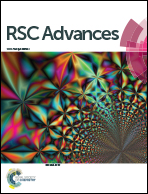One pot synthesis of NiMo–Al2O3 catalysts by solvent-free solid-state method for hydrodesulfurization†
Abstract
A simple and solvent-free solid-state method was used to prepare NiMo–Al2O3 hydrodesulfurization (HDS) catalysts using Ni(NO3)2·6H2O, (NH4)6Mo7O24·4H2O, and AlCl3·6H2O as the solid raw materials and polyethylene glycol (PEG) as an additive. The effects of PEG addition on the precursor thermal decomposition, catalyst properties and dibenzothiophene (DBT) HDS activity were investigated. The as-prepared catalysts were characterized by nitrogen adsorption–desorption measurements, powder X-ray diffraction (XRD), thermogravimetric analysis/differential scanning calorimetry (TGA/DSC), H2 temperature-programmed reduction (H2-TPR), X-ray photoelectron spectroscopy (XPS), scanning electron microscopy (SEM) and high resolution transmission electron microscopy (HRTEM). The results showed that an increase in PEG addition dramatically increases specific surface area and pore volume of the catalyst, and improves Mo sulfidability and active MoS2 dispersion by blocking the aggregation of metals, and consequently increases the number of HDS active sites. However, excess PEG leads to the decrease in specific surface area and pore volume attributed to the metal sintering caused by the strong heat release during thermal decomposition. As a result, dibenzothiophene HDS activity enhanced with increasing PEG addition and peaked at NiMoAl-15 (15% weight ratio of PEG to alumina), which exhibited a significantly higher activity as compared to the NiMo/Al2O3 catalyst prepared by wetness co-impregnation.



 Please wait while we load your content...
Please wait while we load your content...